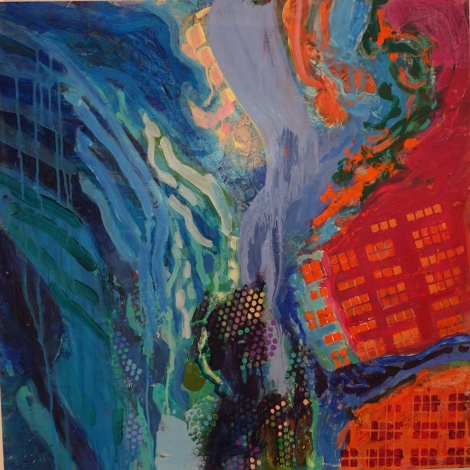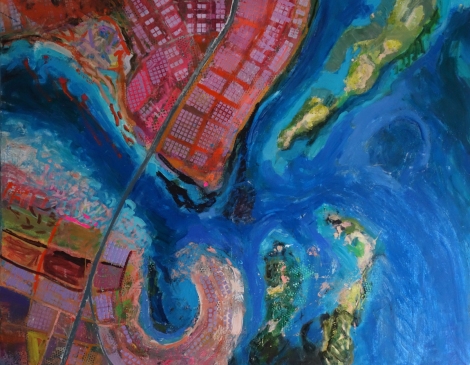This post comes from the Artists and Climate Change Blog
by Guest Blogger Lisa Reindorf
Hurricane Matthew blew into Florida the same night as my exhibit “Building into Water†opened at Galatea Gallery in Boston. The installation, consisting of aerial view paintings, is an interpretation of the coastal ecosystems of Florida.
The aftermath of the storm demonstrated the very issues that I was depicting in my work – the clashes between building and nature that are exacerbated by climate change. Climate change has resulted in floods, waves, and winds that inundate infrastructure and wash away beaches, land, and buildings.
The art that I find most intriguing involves artists confronting social, political, and economic issues. I’ve been an architect, artist, and teacher and I put a lot of thought into why we do things and what is the meaning of our work. My art has been concerned with architectural structures and systems, and their intervention in the natural world. Formally, a grid system is often overlaid with free flowing organic shapes.
Content-wise, I’ve begun focusing on climate change because it is vital to our planet’s survival. As an architect, I dealt with creating structures and considering their impact on the land. My practice has been to minimize negative effects, emphasizing energy conservation and utilizing the land and natural systems in a beneficial manner, such as siting to maximize daylight, reusing water, and minimizing disruption of ecosystems. Now that I am a full time artist, I’ve taken some of these ideas into my artwork.
Artists have a long history of landscape painting, but I wanted to explore current human impact on the land. Land is being drastically reshaped by human intervention and affected by climate change. My work visually addresses the inherent conflict of built infrastructure and ecosystems. Natural systems that have been disturbed by the expansion of man-made structures apply counter-pressure in response to disturbances. In other words, man intrudes into nature and nature strikes back.

In these aerial views, I depict some aspects of this conflict and its confluence with climate change. By building into natural habitats, we interrupt ecosystems, pollute water, put carbon into the environment, and raise temperatures. Nature responds with storms, flooding, and rising tides. Rampant development has invaded and distorted that natural land formation and the systems that keep it healthy.
I begin by looking at aerial views of coastal areas and maps of cities. While these are my inspiration, the works are visual imaginative interpretations. Each piece portrays a specific issue. I decide on the scale, where some areas are zoomed in close and others depict a larger landscape. These square panels are in multiples that can be recombined and reoriented so that it is a general rather than specific interpretation and viewers can create their own narrative.

Paintings such as Toxic Green and Algae Bloom look at the redirection of natural waterways and polluted aquifers that result in toxic algae blooms. Here, neon green shapes bloom in aqua waters. Sand, Sludge and Sea concern runoffs that contribute to sludge, and sandbars that block natural waterways and reshape land.
The rising sea level and increasing tides that are a result climate change are shown in Florida City Aerial View, where the grid and system of cities face encroaching water and eroding shores. In the pieces Third Wave and After the Storm, man-made islands in vibrant colors of neon pink and day-glow orange project into the ocean, connected by long causeways. They are extremely vulnerable to weather events. Tidal Wave and Tsunami depict strong storms and sea water that inundate the structure of the city. In all these pieces, a systematic structure confronts free flowing organic shapes.

Why did I focus on Florida? Florida is literally ground zero for the United States and climate change. Florida’s east coast ranks as the region’s most vulnerable to sea-level rise. Just this week, Hillary Clinton and Al Gore devoted a speech to climate change, which they presented in Miami. They discussed the science behind climate change and concomitant issues such as rising tides and storms.
As the recent hurricane demonstrated, rising sea levels and storm surges inundate cities during major storms. What happens in Florida is just a precursor of what will happen to our coastal areas. Focusing on this issue is particularly important as some politicians even deny the existence of climate change, not to mention its drastic effect on our land.
My intention is not to lecture but to stimulate thought. Artists have a long tradition of exploring the landscape, environment, and planet we live on. We can interpret scientific data and information in ways that are accessible to the public. My hope is to communicate to the audience the urgency of the global climate challenge.
See the article in the October issue of Artscope Magazine for more information.
______________________________
Lisa Reindorf is known for her vibrant mixed media works of architecture and landscapes. The color sensibility is influenced by time spent in Mexico in a community of artists. She has a BA in Design of the Environment from the University of Pennsylvania and received her MA from Columbia University. She was also an instructor at RISD. She is represented by Galatea Gallery in Boston, and has exhibited extensively in NY, California, Mexico and Europe.
______________________________
———-
Artists and Climate Change is a blog that tracks artistic responses from all disciplines to the problem of climate change. It is both a study about what is being done, and a resource for anyone interested in the subject. Art has the power to reframe the conversation about our environmental crisis so it is inclusive, constructive, and conducive to action. Art can, and should, shape our values and behavior so we are better equipped to face the formidable challenge in front of us.
Go to the Artists and Climate Change Blog
Powered by WPeMatico






